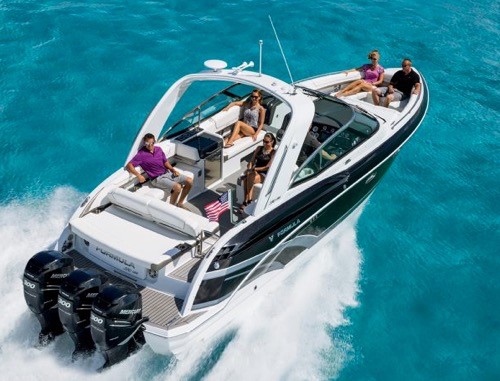Boat Buyer's Guide: Which Drive System is Best?

Outboard Considerations
Outboards are easier to maintain, open up more space inside the boat, and can be tipped up to minimize fouling and corrosion. Boats requiring lots of horsepower can hang three or four big outboards off the stern, corralling enough horses without resorting to esoteric, maintenance-hungry quasi-race motors, or diesel engines. Folks heading offshore who want redundancy usually choose a pair, or trio, of outboards. Even many boats in the 40- to 50-foot range now rely on multiple OBs for power, rather than twin inboards.
Outboards may burn a little more gas than sterndrives and inboards, but not much. Today’s OBs are much more efficient than even their recent ancestors of just 10 years ago. OBs interfere with the swim platform, and can get in the way when fishing, so if watersports are important, this is an issue for one to consider. But they can be jacked in and out to fine-tune the trim of the boat, and, if fitted with joystick electronic steering (an expensive option with some brands), provide excellent maneuverability.

Conventional Inboard Power
Conventional inboards don't do any tricks -- they don't trim, don't turn from side to side, can't be tipped up, and learning to handle a single- or twin-screw inboard boat takes practice. (Adding a bow thruster helps a lot, an option we strongly recommend.) But the shaft, prop, and rudder drivetrain has been pushing boats around for more than a hundred years, and without demanding much TLC -- a zinc anode when necessary, a new Cutless bearing now and then.
The engines that spin the shafts are standard inboards, needing oil changes and other routine maintenance that can be DIY projects or performed by any competent mechanic. No special expertise required, as it is with pods and many outboards. A well-maintained inboard is very reliable and long-lived. Expert mechanics say a skipper can expect 1,000 hours of service from a freshwater-cooled inboard engine if he keeps up with maintenance.
While some builders use V-drives that allow the engines to be mounted aft, straight-shafted inboards take up space amidships, right where the crew can use it most. Compared to pods (see below), standard inboards are dirt cheap. They are the traditionalist's choice. They are the least expensive, easiest to maintain, least costly to repair when running around, and with the addition of a bow thruster, almost as easy to maneuver as a boat with pod drives. That’s why we recommend them in most applications.

Sterndrives
Sterndrives leave the stern platform open for watersports, but take up space in the boat; space that would come in handy for stowage. They use basically the same engines as inboards and demand more maintenance than OBs, but may burn slightly less fuel. They're heavier than outboards, so they will likely not push the boat as fast with equal horsepower.

Dual-prop sterndrives can offset some of the weight penalty, since they're more efficient. They also may keep a boat on plane slightly longer when reducing RPM, are more directionally stable when travelling at slow speeds, and are easier to dock than single props sterndrives.
Most sterndrives cannot lift the drives far enough out of the water to prevent corrosion and fouling, both of which are common problems with SDs. However, they can be tipped up enough to allow beaching and other shallow-water adventures, and have the same advantages as outboards re: adjusting trim and joystick maneuvering.

Pod Drives
Pods are an improvement over straight shafts for maneuvering, since they can be turned from side to side under the boat. Upgraded to a joystick system, these pods can turn independently under the boat, and do not need a bow thruster to maneuver in tight spaces. The twin props on pods are more efficient than single props in many applications, but because they are smaller than straight-shaft props, the engine may have to work harder in some applications.
Forward-facing props (on the Volvo Penta IPS system) enjoy a cleaner water flow than aft-facing props, whose water supply is disturbed by the drive itself. Pods with aft-facing drives (Zeus drives used by Cummins, CAT, and other engine makers) are less vulnerable than forward-facing prop units, and also have most of the inherent efficiencies of forward-facing units. Both systems can be upgraded with joystick systems.
But pods add a lot of cost, demand much more maintenance than their proponents will admit, and can be expensively damaged if they hit anything, which often requires a full replacement of the expensive lower unit. So, what are their advantages?

Their biggest advantage is that they are more fuel-efficient at mid-range cruising speeds. In the few tests conducted by BoatTEST of both inboard power and pod systems in an identical model boat, we concurred with the manufacturers’ claims that pod drives are about 30% more fuel efficient at cruising speeds. Pod makers claim that they also have a higher top speed, and while we have found that to be accurate in some cases, we are not sure it is always true.
Joystick Advantage. When the Volvo Penta IPS was first introduced 10 years ago, it was also equipped with a joystick which made docking far easier for boaters than conventional throttle-and-gear maneuvering. This was the system’s biggest selling point and builders for the first couple of years made the system either standard or an option in over 100 models on the market. However, in time, joystick software and digital control became available for sterndrives, with the addition of a bow thruster (or bow and stern thruster) for inboard engines, and more recently for multi-outboard engine applications as well.